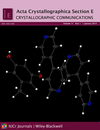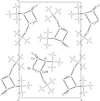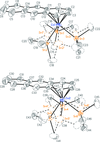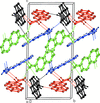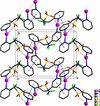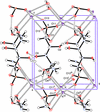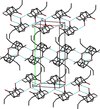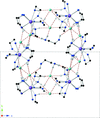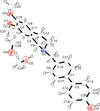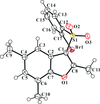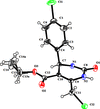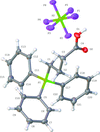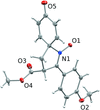issue contents
November 2014 issue

Cover illustration: N-Arylhydroxylamines can be generated in chemical, biochemical and biological systems either by reduction of nitroaromatic compounds or oxidation of arylamines. The compound N-(quinolin-6-yl)hydroxylamine crystallized with four independent molecules in the asymmetric unit. The four molecules are linked via one O-H N and two N-H
N and two N-H N hydrogen bonds, forming a tetramer-like unit. See: Rajapakse, Hillebrand, Lewis, Parsons, Barnes & Gates [Acta Cryst. (2014). E70, 322-324].
N hydrogen bonds, forming a tetramer-like unit. See: Rajapakse, Hillebrand, Lewis, Parsons, Barnes & Gates [Acta Cryst. (2014). E70, 322-324].
editorial
research communications
Download citation


Download citation


In both complex molecules in the asymmetric unit, the FeIII ion has a distorted O5Cl octahedral coordination environment defined by two bidentate 2-ethoxy-6-formylphenolato ligands, one Cl atom and one water molecule. In the crystal, O—H⋯O hydrogen bonds link the two independent molecules to form a dimer while the solvent molecule is linked to the complex molecule by a weak C—H⋯O hydrogen bond. Further weak C—H⋯O interactions along with weak C—H⋯Cl hydrogen bonds link the components into chains parallel to [001].
CCDC reference: 1025672
Download citation


Download citation


The gauche conformation of backbone torsion angles (φ, θ) for β3,-Ac6c-OH is observed in the N-protected derivatives of 1-aminocyclohexaneacetic acid.
Download citation


Download citation


The asymmetric unit of the compound contains two independent conformers. Each conformer is stacked along the a axis to form columns through van der Waals interactions only.
CCDC reference: 1024598
Download citation


Download citation


The thiocyanate ions bind the CuII atoms covalently, forming infinite –Cu—SCN—Cu– chains parallel to the a axis. Two crystallographically independent chains propagate in opposite directions, and are held together in a ribbon arrangement by long bonds between CuII atoms in the first chain and thiocyanate S atoms in the second.
CCDC reference: 1026492
Download citation


Download citation


Crystal structure of bis[(5-amino-1H-1,2,4-triazol-3-yl-κN4)acetato-κO]diaquanickel(II) dihydrate
The title compound, bis[(5-amino-1H-1,2,4-triazol-3-yl-κN4)acetato-κO]diaqua)nickel(II) dihydrate, is the first transition metal complex of 2-(5-amino-1H-1,2,4-triazol-3-yl)acetic acid (ATAA).
CCDC reference: 1026535
Download citation


Download citation


The CrIII atoms in the title compound show a distorted octahedral coordination with four pyridine N atoms in the equatorial plane and two F atoms in axial positions. The [ZnCl3(C5H5N)]− anion has a distorted tetrahedral geometry.
CCDC reference: 1026562
Download citation


Download citation


The hydrogen-bonded structures of both a (1:1) molecular adduct and a salt of 5-(4-bromophenyl)-1,3,4-thiadiazol-2-amine with 4-nitrobenzoic acid and 3,5-dinitrosalicylic acid, respectively, have been determined.
Download citation


Download citation


In the co-crystal of isophthalic acid and [propane-1,3-diylbis(piperidine-4,1-diyl)]bis[(pyridin-4-yl)methanone], molecules are connected into supramolecular chains aligned along the c axis by O—H⋯N hydrogen bonding. These aggregate into supramolecular layers oriented parallel to the ac plane by C—H⋯O interactions.
CCDC reference: 1027139
Download citation


Download citation


Packing in the title keto ester compound is dominated by the formation of inversion dimers by both non-classical hydrogen bonds and offset π–π stacking interactions.
CCDC reference: 864789
Download citation


Download citation


Two phenolate O atoms provided by a Schiff base ligand create a double bridge between Ni2+ and Na+ ions. The coordination environment of the Ni2+ ion is square-planar and it has an unusual seven-coordinated geometry: four atoms from the Schiff base ligand, two from a nitrate anion, which coordinates in a bidentate chelating mode, and one O atom from the coordinated methanol molecule. C—H⋯O weak hydrogen-bond interactions result in the formation of chains along the b-axis direction which are further assembled by bifurcated O—H⋯O hydrogen bonds and π-stacking interactions.
CCDC reference: 1026857
Download citation


Download citation


(NH4)2[FeII2(HPO3)6] exhibits an open-framework structure with channels in which disordered ammonium cations are situated.
CCDC reference: 1027279
Download citation


Download citation


The first reported structure of a cobalt complex containing an η6-anthracene ligand is presented. The anthracene ligand is nearly flat and coordinates the metal asymmetrically, such that the ring junction carbon atoms are slightly further from the cobalt center than are the other four.
CCDC reference: 1027247
Download citation


Download citation


In two benzo[4,5]imidazo[2,1-c][1,4]oxazepine-4-carboxylates, the seven-membered oxazepane rings both have a twist-chair conformation. The dihedral angle between the phenyl ring and the benzimidazole ring system is significantly smaller in one of the compounds, viz. 73.42 (10) compared to 83.07 (17)°.
Download citation


Download citation


In the title compound, the dihedral angle between the two coumarin units is 52.37 (19)°, showing a gauche arrangement across the C—C bond which links the two ring systems. In the crystal, C—H⋯O hydrogen bonds connect centrosymmetrically-related molecules into dimers.
CCDC reference: 1027466
Download citation


Download citation


The title compound crystallized with four independent molecules in the asymmetric unit. They are linked via two N—H⋯O and one O—H⋯N hydrogen bond, forming a tetramer-like unit.
CCDC reference: 861650
Download citation


Download citation


In 3-(4-bromophenylsulfonyl)-2,5,6-trimethyl-1-benzofuran, molecules are linked into a chain along the b-axis direction by C—H⋯π hydrogen bonds and C—Br⋯π interactions.
CCDC reference: 1027923
Download citation


Download citation


The protonated N atom and 2-amine group of the 5-fluorocytosinium (5FC) cation interact with the 3-hydroxypicolinate (3HAP) anion through a pair of nearly-parallel N—H⋯O hydrogen bonds, forming a robust  (8) ring motif. The ions are further linked by N—H⋯N, O—H⋯O, N—H⋯O and C—H⋯O hydrogen bonds, leading to supramolecular wave-like sheets and the crystal structure is further stabilized by C—H⋯π interactions, generating a three-dimensional architecture.
(8) ring motif. The ions are further linked by N—H⋯N, O—H⋯O, N—H⋯O and C—H⋯O hydrogen bonds, leading to supramolecular wave-like sheets and the crystal structure is further stabilized by C—H⋯π interactions, generating a three-dimensional architecture.
CCDC reference: 1027535
Download citation


Download citation


The nitrilium cations of the title compound adopt a slightly distorted linear configuration and are linked through π–π interactions. The nitrilium cations and tetraaluminate anions are arranged in alternating planes parallel to the (011) plane.
CCDC reference: 1027790
Download citation


Download citation


The FeIII ion in the title compound shows a slightly distorted FeCl2N2O2 octahedral coordination geometry. In the crystal, two complex molecules are linked by duplex O—H⋯O hydrogen bonds. Additional hydrogen-bonding interactions lead to the formation of undulating sheets parallel to (010).
CCDC reference: 1027864
Download citation


Download citation


An accurate redetermination of α-DL-methionine provides coordinates for the H atoms, detailed hydrogen-bond geometries and reveals that the side chain is disordered over a major (95%) and a minor (5%) position.
CCDC reference: 1028063
Download citation


Download citation


By refining positional coordinates for the three amino H atoms of a previously published amino acid structure, an improved structural model with shorter and more linear hydrogen bonds is obtained.
CCDC reference: 1028065
Download citation


Download citation


Two isotypic title compounds comprise a 2-iminopyridine ring fused with a cyclooctane ring. In one compound, the cyclooctane ring adopts a twisted chair–chair conformation, while in the second, this ring adopts a twisted boat–chair conformation.
Download citation


Download citation


In a hydrated copper(II) complex, 2-amino-7-methyl-4-oxidopteridine-6-carboxylate and 1,10-phenanthroline ligands chelate the CuII cation while a water molecule further coordinates to the CuII cation to complete the elongated distorted octahedral coordination geometry.
CCDC reference: 1028413
Download citation


Download citation


In this distorted octahedral iridium complex, the three PMe3 ligands are arranged in a meridional geometry, with the chloride ion cis to all three PMe3 groups and the phenyl isothiocyanate ligand bonded in an η2-fashion through the C and S atoms. The geometric parameters for the metal-complexed PhNCS group are compared with other metal-complexed phenyl isothiocyanates, as well as with examples of uncomplexed aryl isothiocyanates.
CCDC reference: 1027097
Download citation


Download citation


Molecules of the title compound are arranged in the solid state in a three-dimensional supramolecular architecture via intermolecular O—H⋯O and C—H⋯O hydrogen bonding and through C—H⋯π interactions.
CCDC reference: 1024475
Download citation


Download citation


In the title compound, the mean plane of the cyclohexane ring is almost normal to the benzene ring and to the mean plane of the 1,2,4-thiadiazinane ring. In the crystal, molecules are linked by N—H⋯O hydrogen bonds, forming chains along [10 ], which are in turn linked via C—H⋯π interactions, forming sheets parallel to (010).
], which are in turn linked via C—H⋯π interactions, forming sheets parallel to (010).
CCDC reference: 1028895
Download citation


Download citation


The RhIII atom in the title compound shows a distorted octahedral coordination geometry. N—H⋯N hydrogen bonds involving the N atoms of the singly deprotonated biimidazolate ligands lead to the formation of inversion dimers.
CCDC reference: 1028912
Download citation


Download citation


Molecules of two related 1,2-amino alcohols are linked via N—H⋯O=S hydrogen bonds, forming chains along [100] for the first compound and along [010] for the second compound.
Download citation


Download citation


In the title compound, the planes of the two indole ring systems are approximately perpendicular to each other, with a dihedral angle of 89.3 (5)°.
CCDC reference: 1028397
Download citation


Download citation


The title compound possesses twofold rotation symmetry, with the planes of the phthalimide moieties inclined to one another by 73.53 (7)° and by 78.62 (9)° to that of the urea unit. In the crystal, molecules are linked via N—H⋯O and O—H⋯O hydrogen bonds, forming a three-dimensional framework structure.
CCDC reference: 1027988
Download citation


Download citation


In 1,1′-bis[1,7-dicarba-closo-dodecaborane(11)], the two {1,7-closo-C2B10H11} cages are linked across a centre of inversion. The position of the second non-linking cage C atom was established unambiguously by geometric and crystallographic methods and there is no evidence of C/B disorder.
CCDC reference: 1027936
Download citation


Download citation


The asymmetric unit of the title compound contains two independent molecules with similar conformations, the cyclohexene rings adopting the same envelope conformation. In the crystal, adjacent molecules are connected via N—H⋯O hydrogen bonds and weak C—H⋯O interactions, forming supramolecular layers parallel to ( 01).
01).
CCDC reference: 1027341
Download citation


Download citation


In the title molecule, the phenyl rings are inclined to one another by 78.63 (17)°. In the crystal, molecules are linked via N—H⋯Cl hydrogen bonds, forming chains along [10-1], which enclose two adjacent  (6) ring motifs.
(6) ring motifs.
CCDC reference: 1029761
Download citation


Download citation


The asymmetric unit consists of an isolated 4-(ammoniomethyl)benzoate zwitterion derived from 4-aminomethylbenzoic acid through the migration of the acidic proton, together with a solvate water that is disordered over three sites. In the crystal structure, N—H⋯O hydrogen bonds together with π–π stacking of the benzene rings result in a strongly linked, compact three-dimensional structure.
CCDC reference: 1029721
Download citation


Download citation


The reaction of AgI with the unsymmetrical ligand N-(pyridine-2-ylmethyl)pyridine-3-amine afforded right- and left-handed helical chains. The AgI atom of the right-handed helical chain adopts a slightly distorted linear coordination geometry, while that of the left-handed helical chain displays a bent geometry.
CCDC reference: 1029928
Download citation


Download citation


In the crystal structure of (I), the molecules are linked into chains by N—H⋯O hydrogen bonds with  (5) ring motifs. After the N-methylation of structure (I), no hydrogen-bonding interactions were observed for structure (II).
(5) ring motifs. After the N-methylation of structure (I), no hydrogen-bonding interactions were observed for structure (II).
Download citation


Download citation


The asymmetric unit of the title compound contains one 3′-azido-3′-deoxythymidine-5′aminocarbonylphosphonate (ACP–AZT) anion, half on an NH4+ cation lying on a twofold rotation axis and, in another position occupied with equal probabilities of 0.5, an NH4+ cation and a water molecule.
CCDC reference: 1028847
Download citation


Download citation


In the crystal structure of the title compound, the morpholine ring adopts the expected chair conformation. The central phenyl ring makes dihedral angles of 67.97 (4) and 7.74 (3)°, respectively, with the benzoate phenyl ring and the lattice mean plane. In the crystal, molecules are linked by C—H⋯O hydrogen bonds.
CCDC reference: 1030398
Download citation


Download citation


In the salt bis(dimethylammonium) hexaaquanickelate(II) bis(sulfate) dihydrate, the NiII cation is located on a centre of inversion and exhibits a slightly distorted octahedral arrangement of water molecules. The noncoordinating water molecules and dimethylammonium cations connect the sulfate and [Ni(H2O)6]2+ octahedra via O—H⋯O and N—H⋯O hydrogen bonds into a three-dimensional framework.
CCDC reference: 1028557
Download citation


Download citation


The anion of potassium (1R)-D-ribit-1-ylsulfonate has an open-chain structure with the potassium cation seven-coordinated in an approximately pentagonal–bipyramidal coordination environment by six different anions through K—O coordinate bonds.
CCDC reference: 1007337
Download citation


Download citation


The crystal structures of two allylated caged molecules and the correlation of bond distances and feasibility of ring-closing metathesis is discussed.
Download citation


Download citation


In the title compound, the acenapthylene ring system and the hydrazinecarbothioamide unit (=N—NH—C=S—NH–) are essentially coplanar, making a dihedral angle of 1.59 (9)°. The molecular conformation is stabilized by two weak intramolecular hydrogen bonds (N—H⋯O and N—H⋯N), which generate S(6) and S(5) ring motifs.
CCDC reference: 1030348
Download citation


Download citation


In the crystal, the molecules form a layered structure parallel to (10 ) via C—H⋯O hydrogen-bonding interactions. Adjacent layers are also linked by C—H⋯O hydrogen bonds, forming a three-dimensional structure.
) via C—H⋯O hydrogen-bonding interactions. Adjacent layers are also linked by C—H⋯O hydrogen bonds, forming a three-dimensional structure.
CCDC reference: 1030212
Download citation


Download citation


The title compound [η5-(C5(CH3)5)(CO)Fe{(μ-BCl)(μ-CO)}PtCl(P(C6H11)3)]·C6H6 shows a piano-stool coordination geometry at the FeII atom and a distorted square-planar coordination geometry at the Pt atom. Both metals are bridged by one carbonyl and one chloridoborylene unit. Additionally, one benzene solvent molecule aligns in a staggered position relative to the (pentamethyl)cyclopentadienyl ligand of the FeII centre.
CCDC reference: 1030674
Download citation


Download citation


The crystal structure of the title compound consists of a ten-coordinate lanthanum(III) cation chelated by five ethylenediamine ligands. This complex co-crystallized with one molecule of ethylenediamine and three chloride anions.
CCDC reference: 1030544
Download citation


Download citation


The IrIII atom in the title molecule adopts a distorted octahedral coordination sphere, being C,N-chelated by two main 2-tert-butoxy-6-fluoro-3-(pyridine-2-yl)pyridine-4-yl ligands and O,O′-chelated by one ancillary pentane-2,4-dionato ligand.
CCDC reference: 1029929
Download citation


Download citation


The crystal structures of the 1:1 salts of nicotine with 3,5-dinitrosalicylic acid and with 5-sulfosalicylic acid both show polymeric hydrogen-bonded and π–π-bonded structures but these differ in that in the first example, cations and anions form separate cation chains or anion columns which are unassociated through formal hydrogen bonds while in the second, hydrogen-bonded cation–anion chains are found.
Download citation


Download citation


The title platinum(II) complex shows a trigonal–bipyramidal coordination and intermolecular C—H⋯Cl, C—H⋯π and (C/O)—H⋯O hydrogen bonds.
CCDC reference: 1031185
Download citation


Download citation


In the title compound, the CuII atom has a distorted octahedral coordination sphere coordinated by the N atoms of two propane-1,3-diamine ligands in the equatorial plane. The axial positions are occupied by a water O atom and an O atom of a disordered perchlorate anion [occupancy ratio 0.631 (9):369 (9)].
CCDC reference: 1031014
Download citation


Download citation


In the title compound, the cyclooctene ring adopts a twist chair–chair conformation. No directional interactions could be identified in the crystal and the packing is governed by van der Waals interactions.
CCDC reference: 1030164
Download citation


Download citation


The structure of an oxygen-containing cycloadduct of C60 fullerene and anthracene is presented, features a unique eight-membered ring.
CCDC reference: 1021977
Download citation


Download citation


The title compound {systematic name: 12,30-diazaheptacyclo[21.13.1.15,19.16,18.110,14.124,36.128,32]dotetraconta-1(37),5(40),6(41),10 (42),11,13,18,23,28,30,32 (39),36 (38)-dodecaene} has syn–anti–syn geometry. Two types of intermolecular short contacts are observed in its crystal structure.
CCDC reference: 1031274
Download citation


Download citation


The asymmetric unit of the title compound contains two independent molecules that are interconnected through an offset π–π interaction. The fused benzene and pyran-2-one rings in each molecule are essentially coplanar. Similarly, the coumarin ring system and the 7-propoxy substituent are close to being coplanar.
CCDC reference: 1031270
data reports
metal-organic compounds
Download citation


Download citation


Download citation


Download citation


Download citation


Download citation


Download citation


Download citation


Download citation


Download citation


Download citation


Download citation


Download citation


Download citation


Download citation


Download citation


Download citation


Download citation


Download citation


Download citation


Download citation


Download citation


Download citation


Download citation


Download citation


Download citation


Download citation


Download citation


Download citation


Download citation


Download citation


Download citation


Download citation


Download citation


organic compounds
Download citation


Download citation


Download citation


Download citation


Download citation


Download citation


Download citation


Download citation


Download citation


Download citation


Download citation


Download citation


Download citation


Download citation


Download citation


Download citation


Download citation


Download citation


Download citation


Download citation


Download citation


Download citation


Download citation


Download citation


Download citation


Download citation


Download citation


Download citation


Download citation


Download citation


Download citation


Download citation


Download citation


Download citation


Download citation


Download citation


Download citation


Download citation


Download citation


Download citation


Download citation


Download citation


Download citation


Download citation


Download citation


Download citation


Download citation


Download citation


Download citation


Download citation


Download citation


Download citation


Download citation


Download citation


Download citation


Download citation


Download citation


Download citation


Download citation


Download citation


Download citation


Download citation


Download citation


Download citation


Download citation


Download citation


Download citation


Download citation


Download citation


Download citation


Download citation


Download citation


Download citation


Download citation


Download citation


Download citation


Download citation


Download citation


Download citation


Download citation


Download citation


Download citation


Download citation


Download citation


Download citation


Download citation


Download citation


Download citation


Download citation


Download citation


Download citation


Download citation


Download citation


Download citation


Download citation


Download citation


Download citation


Download citation


Download citation


Download citation




 journal menu
journal menu








